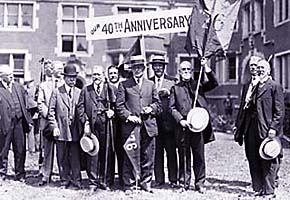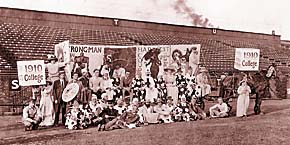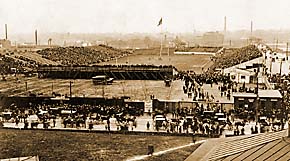
On the occasion of the General Alumni Society’s 100th anniversary, a look back at how the Society helped alumni speak with one voice and become partners in the University community—not to mention persuade the University to ask them for money.
By Mark Frazier Lloyd
Sidebar |At 85, Alumnae Association Assesses Its Future
SEVENTY YEARS AGO this fall, The Pennsylvania Gazette announced a reform in University governance which remains one of the most significant in Penn’s history. After decades of discussion and disagreement, in October 1927 the trustees voted to petition the courts of Pennsylvania to amend the University’s 1791 charter to increase the number of trustees from 24 to 40. Of these, 10 would be “life” trustees and 20 would be “term” trustees, elected to finite terms of service. The remaining 10 would be “alumni” trustees, elected by the direct vote of the members of the General Alumni Society. “For the first time,” said then-Provost Josiah Harmar Penniman, “[there will be] a group of trustees representing the Alumni and elected by them.” The creation of alumni trustees was the culmination of a half-century of steadily increasing alumni involvement in and support for Penn. But it came only after difficult first steps and only when the alumni themselves recognized the role in which they could be of greatest benefit to the University.
The rise of Penn’s alumni to partnership in the leadership of the institution took three full generations to accomplish. After an initial failed attempt in 1836 to form an alumni association for the support of the University, the next try came in 1848 with the establishment of the Society of Alumni — this time to more lasting effect. Alumni advocacy of an enlargement of the University’s educational program, particularly in the fields of history, law, and applied science, resulted in the creation of faculty positions in all three disciplines, with alumni appointed to each, and led to the establishment of the modern Law School and a “School of Mines, Arts and Manufactures,” predecessor to the School of Engineering and Applied Science. Each of these innovations soon matured and brought great, new prestige to the University.
However, the trustees of 1848, in electing new members to their select group, virtually ignored the creative and energetic officers and managers of the Society of Alumni. In the words of Henry Budd, the first historian of the Society of Alumni, the Board of trustees of “1850, and for some time after, was a little too much of the traditional close corporation; it had upon it too few men bound by the recollections of undergraduate days to the college, men who would not feel themselves merely trustees, charged with the proper conduct of an educational institution, but bound up in its traditions, its interests of all kinds, its reputation, whether serious or sportive, part of themselves. Indeed, at one time it seemed as though to be a graduate of the college were a disqualification for election as trustee, or, at least, a handicap placed upon a candidate for that office.”
IN SPITE OF (or perhaps, because of) this perceived constraint, the alumni of all schools increasingly organized. The law alumni formed a society in 1861; the medical alumni followed in 1870. Starting in 1880, incoming Provost William Pepper, C’1862, M’1864, led efforts to create a Central Committee of the Alumni, whose purpose was “a closer connection between the Alumni and the University.” The Committee was composed of 10 representatives each from the collegiate, law, and medical alumni societies, elected annually by graduates who cast their ballots in person on Commencement Day; and it was permitted to nominate alumni trustees for every third vacancy on the Board. Though the nominees were by no means guaranteed election, Pepper successfully instituted the first step towards institutionalized participation by alumni in University governance.

The University expanded rapidly in the 1880s and soon interested alumni were forming still more organizations. Within the decade alumni societies were formed by the graduates of the new Schools of Dentistry, Business Administration, Graduate Arts and Sciences, Veterinary Medicine, and Architecture. Of equal importance were the regional and class alumni societies beginning to form — the New York Society of the Alumni in 1886, a New England society by 1890, followed by the District of Columbia, Chicago, Delaware, and Pittsburgh within the next five years. In 1892 the trustees authorized Provost Pepper to form a committee for proposing changes in the charter of the Central Committee to incorporate these new organizations, but committee leaders resisted and in April 1894 the process apparently came to an end with a communication from the committee to the trustees opposing any changes.
In response to this dilemma the General Alumni Society was born. Again it was William Pepper who recognized the need for innovation, for a united organization of what had truly become a national group of alumni. On Wednesday, June 6, 1894, at 11 a.m., in the University Library, Pepper convened the first meeting of the General Alumni Society. For the first time alumni of all schools participated and resolved that all matriculates of the University in good standing should be members.The first annual meeting was held a year later, on June 12, 1895, when Pepper was elected president and William Lane Winner, D’1885, secretary and treasurer. The General Society’s executive committee represented the College; the schools of Medicine, Law, Dentistry, and Veterinary Medicine; and the Athletic Association. In January 1896 the General Society published the first issue of The Alumni Register, in which Pepper described the need for the Society “in addition to the Central Committee and to the various [school] alumni societies, there is a necessity for an organization with a broader scope”; its purpose “to bring each and all of [the alumni] into touch with the University”; and its methods, which included an alumni office, the Register and other publications, and the celebration of Alumni Day as a major component of Commencement Week. In May 1897 the organization of the Society was finalized when it was incorporated by the Commonwealth of Pennsylvania. “The unification of the University has been practically completed,” Pepper said, “so far as internal organization is concerned. The establishment of the General Alumni Society completes the unification so far as concerns the relations of the graduates.”
Alumni took the greatest interest in athletics. A group of undergraduates formed The Athletic Association in 1873 and in 1879 opened its membership to alumni. In 1882 the alumni incorporated the Athletic Association and obtained from the trustees “certain rights in the control of athletics at the University and the use of a plot of ground for sport.” The Association soon raised $15,000 and built Penn’s first athletic fields and grandstands on the south side of Spruce Street between 36th and 37th Streets (where the Quad now stands). From 1885 to 1895 all athletic competitions were held on these grounds. Granted complete control by the trustees of all finances associated with University athletics, the Association built Penn’s intercollegiate athletic program into one of the nation’s most prominent and most successful. It also proved that its alumni supporters possessed a very substantial capacity for fundraising.
BEGINNING WITH THE relatively modest achievement of $15,000 in 1885, over the next four decades the Athletic Association built the first Franklin Field in 1894-95; the University’s first gymnasium, Weightman Hall in 1903-04; and the adjacent White Training House in 1906-07; then rebuilt Franklin Field in 1922 and added an upper deck in 1925-26, while simultaneously building and opening the Palestra/Hutchinson Gymnasium complex in 1926-27 — thereby effectively bequeathing to the University the athletic facilities it has enjoyed throughout this century.

While the Athletic Association demonstrated the power of the alumni to advance the University’s interests, the General Alumni Society was having difficulty in harnessing the energy and activities of the alumni societies of the University’s several schools, each of which, while electing representatives to the society’s executive committee, also retained autonomy over its own affairs. The result was that the alumni spoke in many and sometimes contradictory voices. At the University Day Dinner of 1911, the new provost, Edgar Fahs Smith, appealed for unification. In March the General Alumni Society published its proposal for merger with the departmental societies, which was accepted by all the schools by spring 1912. In the following year, the regional alumni societies were organized as the Associated Pennsylvania Clubs, which, in turn, joined forces with the General Alumni Society. Finally, in January 1914, the old Central Committee of the Alumni merged into the General Alumni Society. In its annual report for that year the General Society’s board of directors reported, “we expect a solidarity and force which will equip and widen the influence of the University as never before.” The great strength of a united federation of alumni envisioned by William Pepper nearly 20 years before was finally becoming reality.
The reorganized General Alumni Society viewed its responsibilities as providing direct service to the alumni and acting in an advisory capacity to the trustees, provost, and faculty. In the first area, the Society published two alumni magazines, The Pennsylvania Gazette for news and The General Magazine and Historical Chronicle for the cultural and intellectual side of the University. They became, in the words of the Society’s historian, “the greatest bond of union between the University and its graduates.” In addition to the comprehensive mailing lists which it maintained through its publications, the Society also assembled extensive files of news clippings and other documentation on individual alumni and published alumni catalogs in 1917 and 1922.
Advising the trustees and the faculty were somewhat more problematic. The Society had assumed the old Central Committee’s privilege of nominating alumni trustees for every third vacancy on the Board — but took the position that it should have the right to elect alumni trustees directly from its own ranks. It also took on the power of the Central Committee “to appoint committees to visit the University and make recommendations, [which included] occasional visits to classes [and] conferences held with deans, professors and students” — but the faculty, in the words of University historian Edward Potts Cheyney, viewed alumni as “ignorant of the actual conditions that have to be met” and considered their recommendations “ineffective.”
IT WAS IN ADVISING and assisting the provost, then the University’s chief executive officer, that the General Society quickly found its niche. In 1916, the Society presented the University with the Provost’s House, at 4037 Pine Street, having raised $130,000 to purchase, renovate, and maintain the place. The Trustees, delighted with the gift, forwarded to the General Alumni Society a “resolution of thanks in recognition of the loyal and energetic services of the Alumni.” The Society responded with an offer to do more, to establish an endowment fund at Penn, the annual income from which would be used to close the gap between the University’s income and its expenses.
Penn had struggled with this problem since the retirement from the provostship in 1910 of Charles Custis Harrison — one of the wealthiest Philadelphians of his generation, who had made up the annual deficit from his own pocket, with perhaps help from a few others. To replace this largesse, Smith, Harrison’s vice-provost and successor, managed to prevail on the Pennsylvania state legislature to provide Penn with major, annual funding, but within a few years these appropriations were followed by calls for the merger of Penn into a state system of colleges and universities. The trustees and the alumni joined in opposing such a merger, but the alumni took the lead in strengthening Penn’s private resources.

The General Alumni Society called for a $10 million endowment
campaign, pointing out that Harvard, Princeton, and Cornell were
simultaneously engaged in just such a fund drive. Though the Gazette raised
the question repeatedly — “Why Not a Money Campaign?” asked the
feature article for the December 19, 1919 issue — nearly a year passed
before the trustees responded and then only to appoint a committee to
consult with the alumni. Four long years of discussion, planning, and
false starts followed, but the General Society was not to be denied. In
January 1925 the trustees created the University of Pennsylvania Fund,
whose goal was to raise $42 million dollars for Penn — the first
capital campaign in the University’s history.
The trustees installed its members as a voting majority of the
Executive Committee of the Fund, including its chairman, Thomas
Sovereign Gates, but Gates had been active in the General Alumni Society
before he was elected a Trustee and the Society’s leadership knew him
to be an ally. The announcement of the campaign was accompanied by a
comparison of Penn’s endowment to those of comparable major
universities: Harvard, $64 million; Columbia, $48 million; Yale, $40
million. Within 30 months of the Fund’s inauguration, more than $10
million had been subscribed, from 12,000 of the University’s 40,000
alumni.
The fundraising tools assembled over three decades by the General
Alumni Society became the nucleus of the University’s new Development
Office. The trustees hired the Fund’s temporary professional staff. The
Society’s mailing lists formed the basis for the first Annual Giving
program and its biographical files became the Alumni Records office.
Gates, of course, would go on to be elected chairman of the Trustees’
executive committee and then, in 1930, the first president of the
University.
This was the context in which the trustees voted, in May and
October 1927, to reorganize University governance. As the General Alumni
Society looks back on its first hundred years, it should take
particular pride in the extraordinary work of its first three decades,
at the conclusion of which, the alumni were finally welcomed as full
partners in the University community.
Mark Frazier Lloyd is the director of the University Archives and Records Center.
SIDEBAR
At 85, Alumnae Association Assesses Its Future
“FOR THE MONTH of February, we will resign our editorial chairs to the Co-eds of the University, bless ’em! At the end of the month, the Co-eds, bless ’em! will return the mutilated publication to our hands for repairs.” — Punch Bowl, January 1902.
The first women gained admission to Penn in 1876, but gaining respect and access to the same college opportunities as their male classmates came much later. The same was true of Penn’s earliest female graduates, who, after being shut out of the all-male General Alumni Society, formed their own group — the Association of Alumnae — on February 7, 1912.
In the 85 years since, the group waged a decades-long battle for a women’s dormitory (won in 1960 with the opening of what is now Hill House); pushed for a swimming pool for women in the 1920s (Hutchinson Gym and Pool was the result); conducted an educational survey that led to the admission of women to the Engineering and Wharton schools in 1954; and in 1963 helped establish the Continuing Education for Women program, later expanded to include men because of its success.
Today, the Association, which became part of the General Alumni Society in 1946, continues to sponsor various projects, but now that women make up half the undergraduate student body — and as graduates, can participate in the organizations of their choice — does the Association of Alumnae still serve a need at Penn? A questionnaire was recently sent to 268 Penn alumnae to find out what they think.
“What we found out was there were still some people who desired to have this continue, particularly because of the stress on women as far as [juggling] education and jobs and managing a home and playing multiple roles,” says Association President Sally Jannetta, PT’57. “Our focus this year will be to implement some new programs with [women’s issues] in mind and to increase our new membership.”
According to the self-study report, survey respondents agreed that an alumnae association can still play an important role by: facilitating alumnae involvement in Penn’s development; giving women a special voice at the University; providing bonding, camaraderie, and reinforcement for many generations of women; and developing leadership skills for women.

